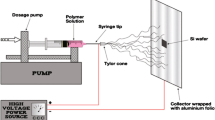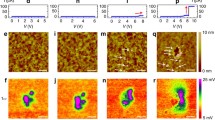Abstract
A new approach of determining dynamic ionic current-voltage characteristic that is due to ion transport phenomenon in the oxide is presented. In this approach, the formulation of I–V characteristics ofmos device can be achieved through the use of the theoretical model of mobile ion distribution in oxides. The used theoretical model of ion distribution is based on the concept that the equilibrium concentration of the ions is obtained when the combined mobilizing forces, namely, thermal diffusion, internal, and external electric fields, become just sufficient to provide necessary activation energy to the ions to surmount the effective potential well. The obtained I–V curve is compared with the experimental curves under varying bias conditions by a slow linear ramp voltage at high temperature (tvs technique). An agreement between the experimental and computed curves provides a support to this method which in turn it gives formulation that is easier to apply for deriving the theoretical I–V characteristic.
Résumé
Une nouvelle approche est présentée pour déterminer un courant ionique dû au phénomène de transport d’ion dans l’oxyde. Dans cette approche, le calcul des caractéristiques I–V d’un dispositifmos est basé sur le modèle théorique de distribution d’ion dans des oxydes. Le modèle théorique employé est basé sur le fait que la concentration d’équilibre des ions est obtenue quand les forces combinées dues à la diffusion thermique, aux champs internes et externes électriques, deviennent suffisantes pour fournir l’énergie d’activation nécessaire aux ions pour surmonter le puits de potentiel efficace. La courbe d’ I–V calculée est comparée avec les courbes expérimentales dans des conditions de déplacement variantes en appliquant l’impulsion de tension de périodes différentes (la techniquetvs). La concordance entre les courbes expérimentales et celles calculées renforcent cette méthode qui permet, en retour, une formulation qui est plus facile à appliquer pour obtenir la caractéristique théorique I–V.
Similar content being viewed by others
References
Yamin (M.), Charge Storage Effects in Silicon Dioxide Films.ieeeTrans. Elect. Dev. (1965),ED-12, pp. 86–96.
Chou (N.J.), Application of Triangular voltage Sweep Method to Mobile Charge Studies inmos Structures,J. Electrochem. Soc. (1971),118, pp. 601–609.
Przewlocki (H. M.),Marciniak (W.), The Triangular Voltage Sweep Method as a Tool in Studies of Mobile Charge inmos Structures.Phys. Stat. Sol. (1975), (a)29, pp. 265–274.
Dmitriev (sg),Markin (Y.V), « Manifestations of the deneutralization of mobile charges in SiO2 in the spectroscopy of the silicon-oxide interface »,Semiconductors (1998),32, no 12, pp.1289–1292.
Kuhn (M.),Silversmith (D. J.), Ionic Contamination and Transport of Mobile Ions inmos Structures,J. Electrochem. Soc. (1971),118, pp. 966–970.
Romanov (V. P.),Chaplygin (Yu. A.), Stationary Distribution of mobile Charge in the Dielectric ofmos Structures,Phy. Stat. (1979), (a)53, pp. 493–498.
Mitra (V.),Bentarzi (H.),Bouderbala (R.),Benfdila (A.), A Theoretical Model for the Density-Distribution of Mobile Ions in the Oxide of the Metal-Oxide-Semiconductor Structures,J. Appl. Phys (1993),73, pp.4287–4291.
Hillen (M. W.),Verwey (J. F.), Mobile ions in SiO2 layers on Si. inBarbottain (G.) andVapaille (A.) ed.,Instabilities in Silicon Devices, vol.I, North-Holland, Amsterdam (1986), pp. 404–439.
Stagg (J.P.), Drift Mobility of Na+ and K+ Ions in SiO2 Films,Appl. Phys. Lett. (1977),31, pp. 532–533.
Goldman (E.I.),Zhdan (A. G.),Chucheva (G.V.), Determination of the coefficients of ion transfer in insulating layers on the surface of semiconductors using dynamic current-voltage depolarization characteristics.Instruments and Experimental Techniques (1997),40, no 6, pp.841–846.
Author information
Authors and Affiliations
Rights and permissions
About this article
Cite this article
Bentarzi, H., Bouderbala, R. & Zerguerras, A. Ionic current in MOS structures. Ann. Télécommun. 59, 485–493 (2004). https://doi.org/10.1007/BF03179707
Received:
Accepted:
Issue Date:
DOI: https://doi.org/10.1007/BF03179707
Key words
- mos structure
- Ionic conduction
- Current voltage characteristic
- Semiconductor device
- Silicium dioxyde
- Charge carrier concentration




